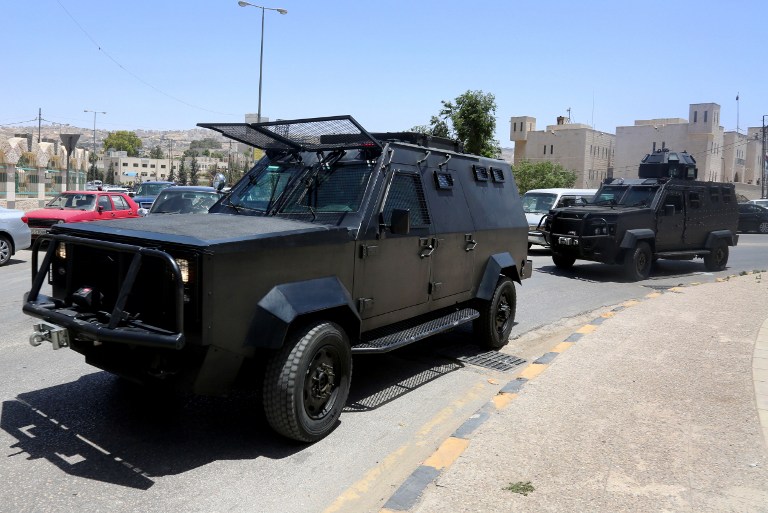Beirut-Jordan has once again fallen victim to terrorist attacks, the latest of which was an assault on the Baqaa refugee camp north of Amman that left five people dead, among them three intelligence members.
Baqaa, the largest of 10 official Palestinian refugee camps in Jordan, lies 20 kilometers west of Amman. Sheikh Abu Mohammed al-Tahawi, a staunch ISIS supporter and one of the first callers for Jihad in Syria, used to reside there.
The radical Islamist society in Jordan witnessed a considerable growth since the war erupted in Syria in 2011. At the start of the conflict, the jihadists preferred to join al-Nusra Front. Yet they began to change their allegiance amid changing circumstances.
Today, the militants prefer to join ISIS. The Jordanian authorities are fully aware of the dangers of such moves, which are compelling them to up security measures across the country.
However, increased measures will consolidate the determination of extremists to join jihadist groups unless they are accompanied by a comprehensive rehabilitation program.
The war in Syria has drawn thousands of extremist and radical militants from around the world. Their numbers had reached around 20,000 militants when the U.S.-led coalition launched attacks on bases belonging to ISIS, leaving it with huge losses both in Iraq and Syria.
Such losses increased defections from within the organization’s ranks, according to foreign embassy reports.
Well-informed sources said that an estimated 2,000 Jordanian militants have joined groups fighting in Syria. Researcher Hassan Haniyeh had previously told Asharq Al-Awsat that around 80 percent of them are now fighting alongside ISIS.
The group’s adoption of extremist sectarian rhetoric has allowed it to mobilize Jordanian youth. This strategy used to be adopted by Abu Musab al-Zarqawi, born Ahmad Fadeel al-Nazal al-Khalayleh, a militant from Jordan who is now considered ISIS’s spiritual leader.
But around ten years after Zarqawi’s death, Jordan’s radical movement is hugely divided. The former animosity between Zarqawi and Abu Mohammed al-Maqdisi has been revived as a result of divisions between ISIS and al-Qaeda-linked al-Nusra Front.
In addition to that, geographic factors have also played a role in compelling young Jordanian men in the past year to join ISIS rather than the ranks of al-Nusra Front. Such a phenomenon has also been noticed in Lebanon.
After security agencies and the Jordanian army blocked the country’s border with southern Syria, where all al-Nusra Front militants were located, Jordanian jihadists were forced to head to Syria via Turkey where ISIS was waiting for them.
Radical Jordanian groups have also suffered huge losses in Syria. According to recent statistics, the number of Jordanians who were killed in Syria has reached 350. Intelligence agencies have also arrested around 400 militants.
One of the clearest examples of the preference of jihadists to join ISIS rather than al-Nusra Front was the case of Ahmed Atta Allah Shebib al-Majali, a member of the Jordanian Air Force, who joined al-Nusra’s ranks in July 2013, according to the Lebanese daily al-Akhbar that is close to so-called Hezbollah.
But Majali later joined ISIS before being killed in the battlefield in the summer of 2014.
Another example is of a boy named Ashraf Khreisat, who has recently appeared in a video, which was allegedly shot in northern Syria, showing him tearing his passport while surrounded by a group of Moroccan men.
Although Jordanians are highly inclined to join ISIS, the older generation of Jordanian radicals prefers to fight alongside al-Nusra Front.
The project of radical militants in Jordan goes beyond the defense of Syria’s Sunnis, observers said, adding that such fighters seek to establish an Islamist government in Jordan.
But such an objective remains far-fetched in a country that is based on a stable constitutional monarchy.
Although the number of supporters for extremist and radical thoughts in Jordan ranges between 8,000 and 12,000, and despite their rise in popularity, the absolute majority of Jordanians does not seek to fight in Syria and does not necessarily back extremist movements such as al-Qaeda and ISIS, in particular after Muath al-Kasasbeh, a Royal Jordanian Air Force pilot, was brutally murdered by ISIS.
Nowadays, less than five percent of the population might back extremist organizations, mainly after Kasasbeh’s killing tarnished the image of radical Jordanians.
In an effort to combat the wave of extremism, Jordanian authorities have taken a series of precautionary measures such as monitoring the border to cut the road to any attempt by more extremists to join radical groups in Syria.
In conclusion, a rise in the number of radical Jordanian militants fighting in Syria has severe repercussions in Jordan. In the long term, this radicalization, in its newest edition, would weaken the traditional social structure.
Now, the highest priority should be to confront the totalitarian ideologies that are promoted by ISIS and which in a dramatic move continue to attract and mobilize more youth.
